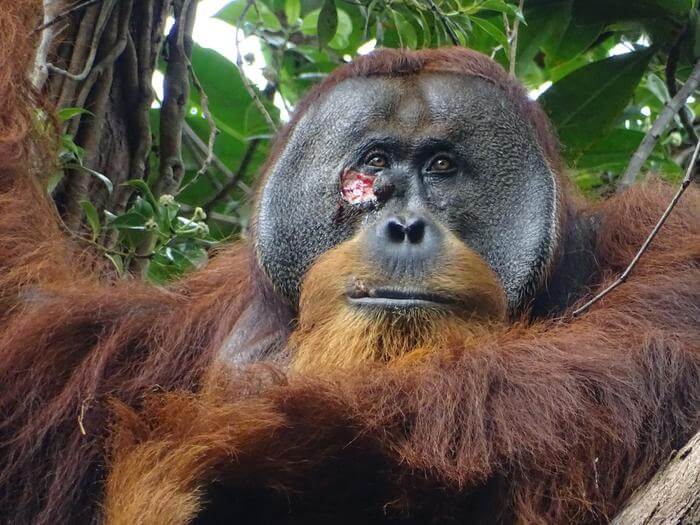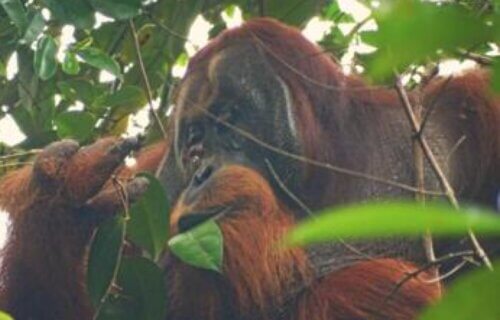MUNICH, Germany — When someone cuts their finger, they put some medicine on it and grab a bandage. Well, researchers have found the first evidence that orangutans do the exact same thing! A team observing a male Sumatran orangutan in the wild spotted him applying pain-relieving plants to an open wound over and over again. It’s the first time humans have seen these primates intentionally taking medicinal plants and using them to treat their injuries.
Researchers from the Max Planck Institute of Animal Behavior in Germany and Universitas Nasional in Indonesia say their discovery suggests that the ability to actively treat injuries with healing plants may have arisen in a common ancestor we share with orangutans millions of years ago. They made the surprising discovery while observing critically endangered Sumatran orangutans in the Suaq Balimbing research area, a protected rainforest in Indonesia.
During their observations, published in Scientific Reports, they noticed that an adult male orangutan named Rakus sustained a nasty facial wound, likely from a fight with a rival male over territory. Three days after the injury, Rakus did something astounding – he started using a type of climbing plant called Akar Kuning (Fibraurea tinctoria) to treat his wound.

Rakus selectively ripped off leaves, chewed on them, and then repeatedly applied the juice to his wound for several minutes. After that, the clever orangutan covered the wound under his eye with more leaves — just like a bandage. What makes this behavior unique is that Fibraurea tinctoria is a proven medicinal plant with various healing properties used in traditional human medicine. Simply put, Rakus literally went to his local drugstore to get the supplies to treat his wound.
“This and related liana species that can be found in tropical forests of Southeast Asia are known for their analgesic and antipyretic effects and are used in traditional medicine to treat various diseases, such as malaria. Analyses of plant chemical compounds show the presence of furanoditerpenoids and protoberberine alkaloids, which are known to have antibacterial, anti-inflammatory, anti-fungal, antioxidant, and other biological activities of relevance to wound healing,” notes lead study author Isabelle Laumer says in a media release.
Over the following days, Rakus’ wound showed no signs of infection and quickly closed up within five days. The researchers also note that he rested more than usual – something that aids wound healing in humans by boosting cell growth and repair processes.
“Sleep positively affects wound healing as growth hormone release, protein synthesis and cell division are increased during sleep,” Laumer explains.
So, was this an intentional effort by Rakus to treat his wound with a medicinal plant or just a lucky guess? The researchers say it appears the orangutan knew what he was doing based on how focused and repeated his wound treatment actions were.
“The behavior of Rakus appeared to be intentional as he selectively treated his facial wound on his right flange, and no other body parts, with the plant juice. The behavior was also repeated several times, not only with the plant juice but also later with more solid plant material until the wound was fully covered. The entire process took a considerable amount of time,” Laumer continues.

Senior author Caroline Schuppli believes that orangutans may have first discovered the healing effects of this plant by accident – after getting sap on their wounds while eating the plant. They may have connected the resulting pain relief from using the plant to future wound treatment — turning it into the orangutan version of Neosporin.
“Orangutans at the site rarely eat the plant. However, individuals may accidentally touch their wounds while feeding on this plant and thus unintentionally apply the plant’s juice to their wounds. As Fibraurea tinctoria has potent analgesic effects, individuals may feel an immediate pain release, causing them to repeat the behavior several times,” Schuppli says.
This appears to be the first documented case of a great ape species actively managing wounds with a biologically active healing substance. While sick animals have been seen avoiding certain foods and ingesting specific plants for self-medication, treating wounds in this way has never been observed before. The researchers believe the behavior could represent a precursor to human wound treatment practices that likely first arose over 4,000 years ago.
“The treatment of human wounds was most likely first mentioned in a medical manuscript that dates back to 2200 BC, which included cleaning, plastering, and bandaging of wounds with certain wound care substances,” Schuppli concludes. “As forms of active wound treatment are not just human, but can also be found in both African and Asian great apes, it is possible that there exists a common underlying mechanism for the recognition and application of substances with medical or functional properties to wounds and that our last common ancestor already showed similar forms of ointment behavior.”
If true, this discovery would push back the evolutionary origins of medicinal wound treatment by millions of years — to a point long before our ancestors were even a glimmer in the fossil record. Modern humans may have simply rediscovered an ancient self-care hack used by our primate predecessors long ago.
